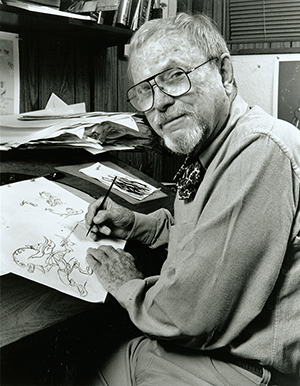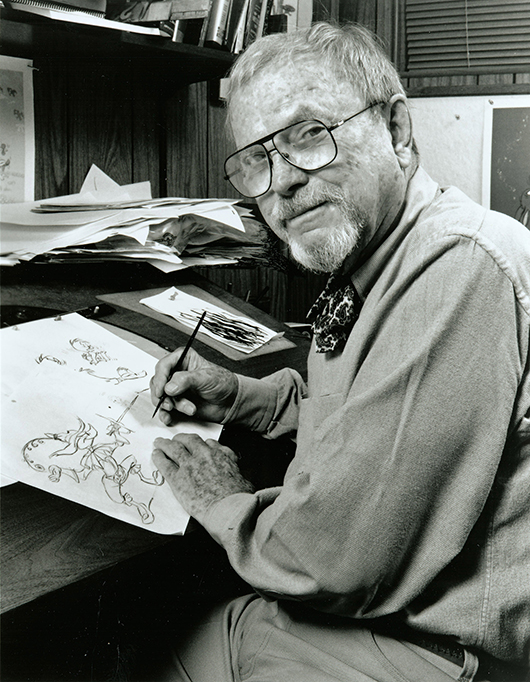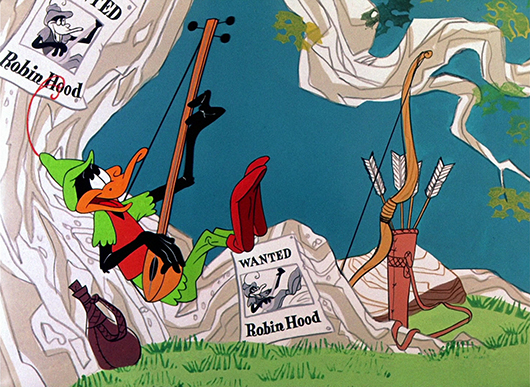
characters in animation history. He perfected the wisecracking Bugs Bunny and the
exasperated Daffy Duck and a host of other characters, including Wile E. Coyote, the
Road Runner, and Pepé Le Pew. He brought an unparalleled talent for comic invention
and a flair for creating distinctive, memorable characters to the art of film animation.
What’s Up, Doc? The Animation Art of Chuck Jones, a new Smithsonian traveling
exhibition that explores Jones’s creative genius, influences, and legacy, will open at
Museum of the Moving Image in New York City on July 19, 2014 and will be on view
through January 19, 2015.
The exhibition is a partnership between the Smithsonian Institution Traveling
Exhibition Service, the Academy of Motion Picture Arts and Sciences, the Chuck Jones
Center for Creativity, and Museum of the Moving Image. After debuting at the
Museum, the exhibition will continue on a thirteen-city tour through 2019.
“Chuck Jones is one of the enduring geniuses of American comedy, as accomplished in
the art of animation as his hero Mark Twain was in literature,” said David Schwartz,
Chief Curator of Museum of the Moving Image, who curated the exhibition with
Barbara Miller, the Museum’s Curator of the Collection and Exhibitions. “His work is
marked by its ability to convey the distinctive personality of his characters, his endless
comic invention, and his mastery of timing and visual and verbal humor.”
In an interview produced for the exhibition, John Lasseter, director of Toy Story and
Toy Story 2, and Chief Creative Officer at Pixar, said “Chuck Jones’s cartoons are useum of the Moving Image Page 2
timeless. They are as funny today as when they were made.”
Trained as a fine artist, Jones graduated from the Chouinard Art Institute (now
California Institute of the Arts) in Los Angeles in 1931. By 1933, he was an assistant
animator making cartoons distributed by Warner Bros. In a career that spanned seven
decades, he created more than 300 animated films and received an Academy Award®
for Lifetime Achievement. After leaving Warner Bros. in 1962, Jones continued to
create award-winning films, including his collaborations with Theodore Geisel (aka Dr.
Seuss).
What’s Up, Doc? The Animation Art of Chuck Jones features 23 of Chuck Jones’s
animated films, a short documentary and an interactive experience—both of which
give insight into the animation process—and more than 125 original sketches and
drawings, storyboards, production backgrounds, animation cels, and photographs that
reveal how Jones and his collaborators worked together to create some of the greatest
cartoons ever made. In addition to the cartoons Jones made for the Warner Bros.’s
Merrie Melodies and Looney Tunes series, the exhibition explores his collaborations
with author Theodore Geisel on the enduringly popular television specials Dr. Seuss’
How the Grinch Stole Christmas (1966) and Horton Hears a Who! (1970); films that
featured the hapless animated character Private Snafu, made for the U.S. Army during
World War II; the Oscar®
-winning public health film So Much for So Little (1949); and
the television special Rikki-Tikki-Tavi (1975), based on a story by Rudyard Kipling.
Among the artifacts in the exhibition are a production sheet from Jones’s directorial
debut The Night Watchman (1938); layout artist Maurice Noble’s background designs
for such popular favorites as Duck Amuck (1953) and Duck Dodgers in the 24½th
Century (1953); a range of artwork created for Jones’s masterpiece What’s Opera,
Doc? (1957); Jones’s character layout drawings that showed his animators how a
character, such as Bugs Bunny or Wile E. Coyote, should move in a particular scene;
and animation cels from Dr. Seuss’ How the Grinch Stole Christmas.
The films, shown as large wall projections and on monitors throughout the exhibition,
include such classic Warner Bros. cartoons as What’s Opera, Doc? and One Froggy
Evening (1955), and the Academy Award-winning short The Dot and the Line: A
Romance in Lower Mathematics (1965), which expanded the boundaries of the
medium with its experimental techniques. Some of the films and clips include
introductions by John Lasseter.
The exhibition also includes behind-the-scenes audio of Jones directing Mel Blanc
(voice of Bugs Bunny) and Arthur Q. Bryan (Elmer Fudd), and excerpts from interviews
with Jones. An interactive experience will allow visitors to take on the role of animation
director by manipulating character movement and timing.
useum of the Moving Image Page 3
In conjunction with the exhibition, Museum of the Moving Image will present Chuck
Jones Matinees, an ongoing series of screenings and programs, and education
programs. Each weekend afternoon, the Museum will screen films directed by Chuck
Jones in its majestic Sumner M. Redstone Theater; some will be accompanied by
personal appearances by Jones’s collaborators and top creative figures in animation
who considered him an influence on their own work. The cartoons and feature films
in Chuck Jones Matinees will be shown in 35mm and 16mm prints provided by the
Chuck Jones Center for Creativity and the Academy of Motion Picture Arts and
Sciences. For young visitors, the Museum will offer animation demonstrations and
related activities in the Saturday Drop-in Studio (12:00 to 5:00 p.m.) with special
workshops and tours planned over holiday periods. The Museum is also developing
programs for student groups. A full schedule with descriptions for screenings and
education programs will be announced soon.
Museum of the Moving Image Curator of the Collection and Exhibitions, Barbara Miller,
and Chief Curator, David Schwartz, served as exhibition curators for What’s Up, Doc?
The Animation Art of Chuck Jones. Wendell Walker, the Museum’s Deputy Director for
Operations, Exhibition, and Design, also served as part of the team developing the
exhibition for the Museum and its national tour.
About the Smithsonian Institution Traveling Exhibition Service
SITES has been sharing the wealth of Smithsonian collections and research programs
with millions of people outside Washington, D.C., for more than 60 years. SITES
connects Americans to their shared cultural heritage through a wide range of
exhibitions about art, science and history, which are shown wherever people live, work
and play. Exhibition descriptions and tour schedules are available at sites.si.edu.
About Museum of the Moving Image
Museum of the Moving Image advances the public understanding, enjoyment, and
appreciation of film, television, and digital media. In its expanded and renovated facility
in New York City—acclaimed for accessibility and bold design—the Museum presents
innovative interactive exhibitions; screenings of significant works; discussion
programs featuring actors, directors, craftspeople, and business leaders; and dynamic
education programs. The Museum maintains the nation’s largest and most
comprehensive collection of artifacts—more than 130,000 artifacts— relating to the
art, history, and technology of the moving image. More information is available at
movingimage.us.
ADDITIONAL IMAGES OF NOTE




